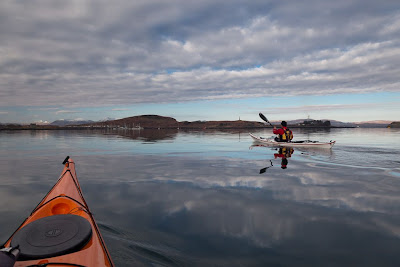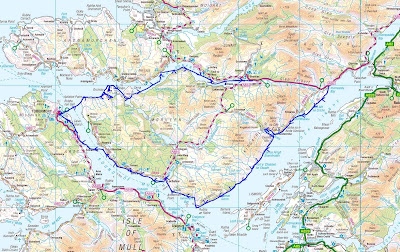Glasgow Green to Erskine.
Erskine to Port Glasgow.
A 33km day paddle on the tidal reaches of the river River Clyde from Glasgow Green to Port Glasgow.
The Arc frames the Glasgow Tower.
HMS Dragon undergoing final fitting out at BAE Systems yard at Scotstoun.
Tides
HW Port Glasgow: +0010 HW Greenock
HW Glasgow: +0020 HW Greenock
Streams turn about local HW and LW.
We launched at 2 hours before HW Glasgow, 5 days before springs. We took 7 hours 40 minutes to complete the trip as we spent a lot of time on the first section to Renfrew. The ebb current became noticeable at 1 hour after HW Glasgow about 8km down stream at Scotstoun. It was moving at 5km/hour and persisted at this rate until 2 hours after HW, by which time we were 17km downstream at Erskine. Beyond Erskine the ebb remained about 3km/hr until we reached Port Glasgow, 30 minutes before local LW.
Note that large ships will manoeuvre on the section up to the KGV dock, timing their arrival or departure for HW Glasgow. There is plenty to keep you occupied further up river before then, so that you pass KGV dock well after HW.
Until recently, Clyde Estuary Control would only let a yacht proceed further up than Bowling with advanced written permission. Canoes and kayaks were only allowed to make the trip as part of an organised "Annual Clydeport Paddle" trip with safety cover provided by the
Glasgow Humane Society.
Although this trip was carried out with the permission of Clydeport on the day and the knowledge of the SCA, it should be seen as a trial run. Details have yet to be finalised but it is hoped that trips by competent individuals will shortly be allowed. It is likely that the protocol will be similar to that which we followed on the day, which is outlined below. The SCA will post final details on their website once they are informed by Clydeport.
Before setting off, you should contact
Clyde Estuary Control on VHF channel 12, tel: 01475726221, who will inform you of any shipping movements or whether seaplanes are expected to land/take off and warn of areas to avoid, which side of the river to follow etc..
You can download the
Clydeport Marine Leisure guide from their website.
You should also contact Clyde coastguard on channel 16, tel: 01475729988 and contact them again once you are off the water. You need to carry a VHF and listen for warnings on channels 12 and 16. You also need to leave your VHF call sign with the coastguard.
Launching/landing sites:
The access gates at Glasgow Green below the tidal weir are locked with a combination padlock. The current combination can be obtained from the
Scottish Canoe Association or Sue Hilder, Glasgow City Council Outdoor Access Officer. Tel: 0141 287 8585.
From Glasgow Green, there are no places to land until you get to the slipways at
Renfrew and
Yoker, which are in use again by the current landing craft style ferries. The ferry crew did not object to a small group of three kayaks landing there for a break, because we kept well to the edge of the slip. I would not choose to stop with a large party, launch or take out there due to the ferry operations.
The next suitable launch and landing sites are at the
Erskine and
Old Kilpatrick slipways of the old Erskine ferry.
Downstream the
traditional kayak launching site at Bowling (
Canoe Boys) is now very difficult since the canal basin was redeveloped, unless you have a trolley and are prepared to drag the kayak through the woods on a dog walkers' track beyond the cycle shop in the old railway arch. However, it is an excellent place to stop for a break.
Downstream at Dumbarton Rock
park near the Bowling club where you can launch at mid to high tide. At low tide you can launch into the Leven on the
NW side of Dumbarton rock. The mud flats east of Dumbarton Rock are part of the Inner Clyde SSSI and are a special protected area (SPA). They are supposed to be important winter feeding areas for waders such as red shank and oyster catchers but anytime I have been there at low tide, I have seen none, though we saw plenty higher up river towards Bowling from our kayaks.
Still on the north bank
park and launch here at Ardmore Point at high tide or trolley
along the path at low tide.
On the south bank
Kelburn Park near Port Glasgow is good at mid to high tide.
Newark Castle (Lamont's) slipway is good at all states of tide. Still in Port Glasgow,
Coronation park slipway is good at mid to high tide, not sure about low tide.
I would not leave a car overnight at any of these locations.
Sea kayaking from a dear green place.
Sea kayaking the River Clyde: Glasgow Green to the Merchant City.
All Greatness Stands Firm in The Storm.
Famous for not being able to walk in a straight line.
The Clyde, a river of change.
Forward paddling, through the years, on the Clyde.
A tale of two Clyde Titans; one is still standing.
Duncan takes a final curtsy on the Clyde.
Life and death on the Clyde.
Bowling down the Clyde in the Comet's wake.
Clyde built: tough ships, tough people.
Photo Album map.


















































